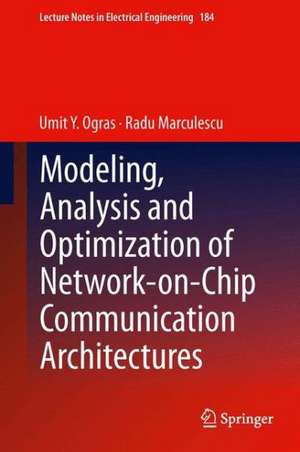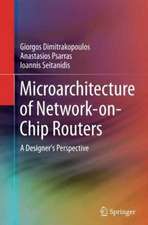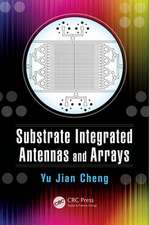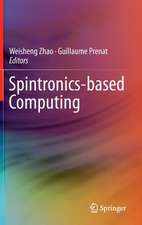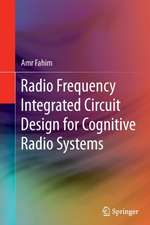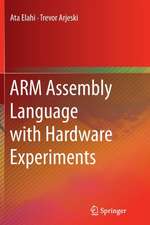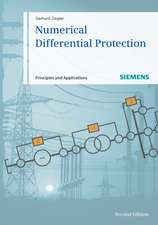Modeling, Analysis and Optimization of Network-on-Chip Communication Architectures: Lecture Notes in Electrical Engineering, cartea 184
Autor Umit Y. Ogras, Radu Marculescuen Limba Engleză Hardback – 26 mar 2013
In this dissertation, we study outstanding research problems related to modeling, analysis and optimization of NoC communication architectures. More precisely, we present novel design methodologies, software tools and FPGA prototypes to aid the design of application-specific NoCs.
| Toate formatele și edițiile | Preț | Express |
|---|---|---|
| Paperback (1) | 635.15 lei 6-8 săpt. | |
| SPRINGER NETHERLANDS – 3 apr 2015 | 635.15 lei 6-8 săpt. | |
| Hardback (1) | 638.43 lei 6-8 săpt. | |
| SPRINGER NETHERLANDS – 26 mar 2013 | 638.43 lei 6-8 săpt. |
Din seria Lecture Notes in Electrical Engineering
- 18%
 Preț: 1859.04 lei
Preț: 1859.04 lei - 18%
 Preț: 895.27 lei
Preț: 895.27 lei - 17%
 Preț: 397.66 lei
Preț: 397.66 lei - 18%
 Preț: 1562.17 lei
Preț: 1562.17 lei - 20%
 Preț: 1473.39 lei
Preț: 1473.39 lei - 18%
 Preț: 5169.60 lei
Preț: 5169.60 lei - 20%
 Preț: 1741.49 lei
Preț: 1741.49 lei - 20%
 Preț: 1918.04 lei
Preț: 1918.04 lei - 18%
 Preț: 1573.20 lei
Preț: 1573.20 lei - 18%
 Preț: 1851.77 lei
Preț: 1851.77 lei - 18%
 Preț: 1578.72 lei
Preț: 1578.72 lei - 18%
 Preț: 1903.08 lei
Preț: 1903.08 lei - 18%
 Preț: 2113.02 lei
Preț: 2113.02 lei - 18%
 Preț: 892.42 lei
Preț: 892.42 lei - 18%
 Preț: 1404.30 lei
Preț: 1404.30 lei - 18%
 Preț: 1133.61 lei
Preț: 1133.61 lei - 18%
 Preț: 1847.84 lei
Preț: 1847.84 lei - 18%
 Preț: 1384.56 lei
Preț: 1384.56 lei - 20%
 Preț: 1300.14 lei
Preț: 1300.14 lei - 20%
 Preț: 1174.76 lei
Preț: 1174.76 lei - 20%
 Preț: 1310.03 lei
Preț: 1310.03 lei - 18%
 Preț: 2546.29 lei
Preț: 2546.29 lei - 20%
 Preț: 1310.03 lei
Preț: 1310.03 lei - 18%
 Preț: 1676.58 lei
Preț: 1676.58 lei - 20%
 Preț: 1182.20 lei
Preț: 1182.20 lei - 18%
 Preț: 1392.46 lei
Preț: 1392.46 lei - 18%
 Preț: 1119.38 lei
Preț: 1119.38 lei - 18%
 Preț: 1678.16 lei
Preț: 1678.16 lei - 18%
 Preț: 1596.85 lei
Preț: 1596.85 lei - 18%
 Preț: 1398.00 lei
Preț: 1398.00 lei - 20%
 Preț: 1445.35 lei
Preț: 1445.35 lei - 18%
 Preț: 1244.89 lei
Preț: 1244.89 lei - 20%
 Preț: 1173.10 lei
Preț: 1173.10 lei - 18%
 Preț: 810.81 lei
Preț: 810.81 lei - 20%
 Preț: 1173.93 lei
Preț: 1173.93 lei - 20%
 Preț: 1482.47 lei
Preț: 1482.47 lei - 20%
 Preț: 1915.57 lei
Preț: 1915.57 lei - 18%
 Preț: 1387.73 lei
Preț: 1387.73 lei - 18%
 Preț: 1425.62 lei
Preț: 1425.62 lei - 20%
 Preț: 1297.67 lei
Preț: 1297.67 lei - 18%
 Preț: 1407.46 lei
Preț: 1407.46 lei - 18%
 Preț: 1667.91 lei
Preț: 1667.91 lei - 18%
 Preț: 1400.35 lei
Preț: 1400.35 lei - 18%
 Preț: 1117.03 lei
Preț: 1117.03 lei - 18%
 Preț: 1573.20 lei
Preț: 1573.20 lei - 18%
 Preț: 1405.90 lei
Preț: 1405.90 lei - 18%
 Preț: 726.37 lei
Preț: 726.37 lei - 18%
 Preț: 1405.90 lei
Preț: 1405.90 lei - 18%
 Preț: 1238.56 lei
Preț: 1238.56 lei - 18%
 Preț: 725.61 lei
Preț: 725.61 lei
Preț: 638.43 lei
Preț vechi: 751.10 lei
-15% Nou
Puncte Express: 958
Preț estimativ în valută:
122.18€ • 126.59$ • 101.97£
122.18€ • 126.59$ • 101.97£
Carte tipărită la comandă
Livrare economică 21 martie-04 aprilie
Preluare comenzi: 021 569.72.76
Specificații
ISBN-13: 9789400739574
ISBN-10: 9400739575
Pagini: 188
Ilustrații: XIV, 174 p.
Dimensiuni: 155 x 235 x 14 mm
Greutate: 0.36 kg
Ediția:2013
Editura: SPRINGER NETHERLANDS
Colecția Springer
Seria Lecture Notes in Electrical Engineering
Locul publicării:Dordrecht, Netherlands
ISBN-10: 9400739575
Pagini: 188
Ilustrații: XIV, 174 p.
Dimensiuni: 155 x 235 x 14 mm
Greutate: 0.36 kg
Ediția:2013
Editura: SPRINGER NETHERLANDS
Colecția Springer
Seria Lecture Notes in Electrical Engineering
Locul publicării:Dordrecht, Netherlands
Public țintă
ResearchCuprins
Introduction.- Literature Survey.- Motivational Example: MPEG-2 Encoder Design.- Target NoC Platform.- NoCPerformance Analysis.- Application-specific NoC Architecture Custimization using Long-range Links.- Analysis and Optimization of Prediction-based Flow Control in Networks-on-Chip.- Design and Management of VFI Partition Networks-on-Chip.- Conclusion.- Bibliography.- Appendix A. Tools and FPGA prototype.- Appendix B. Experiments using the Single-chip Cloud Computer (SCC) Platform.
Textul de pe ultima copertă
Traditionally, design space exploration for Systems-on-Chip (SoCs) has focused on the computational aspects of the problem at hand. However, as the number of components on a single chip and their performance continue to increase, the communication architecture plays a major role in the area, performance and energy consumption of the overall system. As a result, a shift from computation-based to communication-based design becomes mandatory. Towards this end, network-on-chip (NoC) communication architectures have emerged recently as a promising alternative to classical bus and point-to-point communication architectures.
This book explores outstanding research problems related to modeling, analysis and optimization of NoC communication architectures. More precisely, we present novel design methodologies, software tools and FPGA prototypes to aid the design of application-specific NoCs.
This book explores outstanding research problems related to modeling, analysis and optimization of NoC communication architectures. More precisely, we present novel design methodologies, software tools and FPGA prototypes to aid the design of application-specific NoCs.
Caracteristici
Presented is a mathematical model for on-chip routers and use this model for NoC performance analysis Our performance analysis approach can be used not only to obtain fast and accurate performance estimates, but also to guide the NoC design process within an optimization loop, since it can be performed much faster than simulation Presented is a methodology to automatically synthesize an NoC architecture which is a superposition of a few long-range links and a standard mesh network The few application-specific longrange links we insert significantly increase the critical traffic workload at which the network transitions from a free to a congested state This way, we can exploit the benefits offered by both complete regularity and partial topology customization Considered is a flow control algorithms specifically developed for NoCs and propose a predictive closed-loop flow control mechanism Our technique controls the packet injection rate at traffic sources in order to regulate the total number of packets in the network Experiments on an FPGA prototype and simulation results demonstrate that significant reduction in the average and maximum packet latency is achieved due to the proposed controller Increasing energy consumption and synchronization are major problems in the design of NoCs To this end, we present a design methodology for partitioning an NoC architecture into multiple voltage-frequency islands (VFIs) and assigning supply and threshold voltage levels to each VFI Simulation results show about 40% savings for a real video application.VFIs Finally, we support our theoretical findings by actual FPGA-based implementations Includes supplementary material: sn.pub/extras
